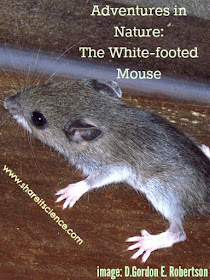I was out with my dog a few days ago and she began to wildly sniff one of our hydrangea bushes. The bush had many dried flowers and had caught a lot of deciduous tree leaves, so it was difficult to see what she might find so exciting. All of a sudden she jumped onto the bush, but it didn't support her weight, so she crashed down into it.
As this happened I spotted some movement. At first I thought it was a small bird. Then as it jumped from the bush onto the split rail fence behind I recognized the creature immediately as a white-footed mouse, or deer mouse. Luckily my pup was still fixated on the bush and I was able to observe for a few seconds before we left the animal alone.
White-footed mice are unmistakable with their two toned fur, brown on top and white on the belly and feet. They have bulgy shiny black button eyes and a long tail. Remembering seeing photographs of the white-footed mouse nesting in bird nests and other clumps of leaf and grass litter I wondered if it was possible that the mouse was nesting in the leaves that had been caught in the dense brittle branches of the hydrangea bush.
 |
| image: NPS, Public Domain |
 |
| White-footed mouse tracks in the snow.
U.S. Fish and Wildlife Service- Northeast Region U.S. Fish and Wildlife Service- Northeast Region |
These book suggestions are affiliate links. Please see disclosures for more details.
Two little treasures about the white-footed mouse:
Deer mouse at Old Farm Road is in the Smithsonian Backyard Series. These are mini-books written in a scientifically accurate way for kids.
Whitefoot: A Story From the Center of the World by environmental author Wendell Berry is another tiny book for children and adults.
There is always more to find out when you look a little closer! What natural discoveries have you made recently? Share with us on Facebook, by e-mail or by commenting below.


No comments:
Post a Comment